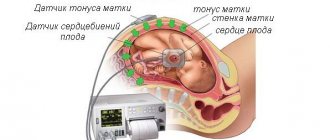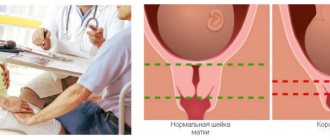The happiness of pregnancy is weighed against the risks of losing it. Bearing a child is no less a difficult task for a woman than conceiving one. The problems that await a woman along this path are varied. One of the causes of spontaneous isthmic-cervical insufficiency or ICI. We are talking about a soft, insufficiently long cervix. In this situation, Utrozhestan for a short cervix is one of the first aid options. The injected drug helps the body equalize hormonal levels, on which the child’s life depends.
Indications
For the normal course of pregnancy, especially in the early stages, a sufficient level of progesterone in the blood is necessary. In the first weeks, the corpus luteum in the ovaries, which remains after ovulation, is responsible for its production.
Utrozhestan for the cervix during pregnancy is a supplier of missing progesterone.
It is this hormone that is necessary for the successful attachment of the embryo into the uterine cavity, is important for the normal functioning of the mammary glands, and for further breastfeeding of the child.
It is also required to prepare organs for pregnancy and childbirth - it ensures relaxation of the uterus, its growth and eliminates the threat of spontaneous abortion
ICI, if not known before conception, is most often diagnosed at 14-17 weeks using ultrasound. During this period, a woman may experience light spotting, which indicates a threat of miscarriage. Utrozhestan during pregnancy with a short cervix has a direct effect on the gestation process. It helps eliminate uterine spasms and make the cervix itself more elastic, thereby preventing the opening of the cervical canal.
https://youtu.be/6XrLItbz4ko
Cervix: without pregnancy and with it
The uterus ends with the cervix and leads the organ into the vagina. Without pregnancy, its size is 3–4 centimeters, and the cervical canal, which runs inside and is filled with mucus, is tightly closed. In the middle of the menstrual cycle, under the influence of hormones, the mucus thins, allowing sperm to enter the cervix. This is how they enter the uterine cavity to fuse with the egg. Pregnancy begins. After conception, the pink, smooth neck becomes swollen blue-red, which indicates intense blood circulation. Its entrance is normally tightly closed.
Table of optimal cervical length indicators
| Gestational age | Cervical length |
| 1–20 weeks | 40–45 mm |
| 20–28 weeks | 35–45 mm |
| 28–32 weeks | 30–35 mm |
| 32–36 weeks | 25–30 mm |
| After 37 weeks | less than 25 mm |
Woman's feelings from therapy
The effect of administered progesterone on the body of a pregnant woman is usually little noticeable physically. The result of taking the hormone may be some drowsiness, dizziness and mild malaise - these are side effects. Many women are interested in whether Utrozhestan raises basal temperature. There is no official data on this effect from the manufacturer. But there is still a certain hyperthermic effect on the body.
Like progesterone produced by organisms, utrogestan affects a woman’s basal temperature. Those women who regularly keep a schedule of their BBT note that the basal temperature when taking Utrozhestan increases by 0.1-0.5 degrees.
This is a normal reaction of the body, both in the luteal phase of the cycle and during early pregnancy. In rare cases, Utrozhestan also increases body temperature and causes malaise. But usually this phenomenon goes away on its own, a few hours after administration.
What is better: progesterone injections or Utrozhestan?
The product is available in capsules of 100 and 200 mg. It is more rational to use vaginal administration of the drug during pregnancy. There is no load on the liver, the hormone is delivered directly to the target. An analogue is progesterone injections. But not all women are ready to endure injections. In any case, the choice of preparative form and dosage of the hormone is selected by the doctor.
Subtleties of therapy
One of the features of taking hormonal drugs is the method of stopping therapy. You should stop taking the drug gradually, each time reducing the dose by 25-50 mg. The situation when, after stopping Utrozhestan, the lower abdomen pulls is not uncommon. In most cases, it indicates an early or abrupt end of therapy.
Can the lower abdomen hurt from Utrozhestan?
This phenomenon is sometimes observed. It is not included in the list of side effects. It is important, when your stomach feels tight after Utrozhestan, to try to differentiate the condition from pain caused by a growing uterus, which is a relative norm during pregnancy. If such symptoms occur, you should inform your doctor.
It rarely happens that individual intolerance to the administered hormone or components of the drug manifests itself in this way. Such a signal may indicate an incorrect dose of the drug and a threat of miscarriage.
Could there be a daub from Utrozhestan?
The main purpose of progesterone is to preserve pregnancy. Often the drug is prescribed just when the first symptoms of spontaneous abortion appear - spotting. Therefore, the body’s reaction when spotting began after Utrozhestan requires urgent consultation with a specialist. It is necessary to conduct an ultrasound and make sure that everything is fine with the child.
Like any other medication, utrozhestan is prescribed by a specialist who monitors a pregnant woman. Ideally, after a blood test to determine the level of the hormone in the blood, since CSM can occur for a number of reasons, not only due to a lack of progesterone. Any independent actions can only do harm. Indeed, in addition to the low concentration of the hormone, its excess is also dangerous.
Utrozhestan is a synthetic analogue of the female hormone progesterone, which is produced by the corpus luteum of the ovaries and placenta. The medicine is often prescribed for the diagnosis of “short cervix” in pregnant women.
Preservation of pregnancy with a short cervix
To maintain pregnancy and its normal course, a pregnant woman is recommended to remain in bed. In severe cases of the disease, hospitalization is indicated.
It is necessary to visit a gynecologist according to the established schedule and follow all appointments and recommendations.
When carrying a child, pregnant women with a short cervix should not be exposed to stress and anxiety.
If necessary, undergo additional diagnostic methods:
- Dopplerography;
- Echocardiography;
- Abdominal and transvaginal examination (no later than 15 weeks);
- Ultrasound + screening.
Physical activity and excess weight of a pregnant woman worsens the situation. However, completely giving up exercise and going on a diet is not recommended.
Physical activity can be replaced with yoga for pregnant women. And to maintain body weight, avoid eating fatty foods, flour products and large amounts of carbohydrates.
You can’t listen to the idea of “eating for two.” A large fetus with a shortened cervical canal adversely affects the organ and the gestation process itself.
If you have a pessary or surgical sutures, you must follow all these steps.
To reduce the load, you should wear a bandage.
Intimacy is not a contraindication for a short os. It should be limited if there are clinical symptoms and the first days after suturing.
Utrozhestan - rules of application
If you have a short cervix, Utrozhestan is prescribed - it reduces the likelihood of spontaneous abortion. It is produced in capsules and vaginal suppositories, each of which contains 0.1 or 0.2 g of progesterone.
How to take the medicine for a shortened cervix:
- In capsules, Utrozhestan is prescribed 0.4 g at a time every 6 or 8 hours. After the threat of termination of pregnancy with a short cervix disappears, the dose is gradually reduced to 0.6 g/day.
- Utrozhestan in suppositories should be used until the 12th week in the morning and evening, 0.1 or 0.2 g of the medicine. If the cervix is short, suppositories should be inserted as deeply as possible, after which you should lie down for at least 20 minutes.
The course of treatment with Utrozhestan for a shortened cervix is long, you can drink it up to 36 weeks, if there are no contraindications. This hormonal drug does not affect the development of the fetus, there is no swelling during therapy, and blood pressure does not increase. The drug is natural, so side effects are considered an extremely rare event.
Most women with a shortened neck tolerate the drug well; the main complaints are drowsiness, decreased attention, dizziness, and adverse reactions appear within an hour. Less commonly, dyspeptic disorders occur in the form of diarrhea, constipation, nausea, vomiting - if such symptoms appear, you should consult your doctor about the advisability of reducing the dosage.
Utrozhestan is one of the mandatory components of the support regimen during pregnancy after IVF in all its interpretations.
A shortened cervix is a dangerous pathology that can cause miscarriage. Utrozhestan is an effective and safe remedy, but it can only be used as prescribed by a gynecologist and under constant medical supervision.
Utrozhestan is a hormonal drug from the group of gestagens. Utrozhestan is prescribed to pregnant women for hormonal imbalances during pregnancy, which can lead to spontaneous abortion (miscarriage). Utrozhestan is also used as the main drug for the treatment of infertility and in cases of artificial insemination to maintain hormonal balance in a woman’s body.
Utrozhestan is available in the form of capsules for oral administration, suppositories (vaginal suppositories), dosages of 100 and 200 mg. This form of release allows you to conveniently use the drug and select the required dose individually for each pregnant woman.
Shortening of the cervix: why does it happen?
Shortening of the cervix is the most common causative factor of miscarriage. According to statistics, more than 41% of late natural abortions and early births occur precisely because of this. The diagnosis is often made between 15 and 20 weeks of gestation. Fatal for prolongation of pregnancy is a length below 3 centimeters at the 20th week. Shortening to 2 centimeters or less by week 27 is an indication for obstetric correction.
Causes of pathology:
- traumatic damage to an organ in a previous birth;
- abortions that damage its elasticity;
- anatomical defects (genital infantilism);
- excess production of androgens.
Abnormalities of the cervix contribute to its shortening during gestation.
As the fetus grows towards the end of the second trimester, it puts more pressure on the lower uterine segment. The risk of cervical shortening increases if a woman is carrying more than one fetus, as well as with polyhydramnios.
When to sound the alarm
80% of episodes of shortening occur gradually, and are detected only during a routine ultrasound in the second trimester of pregnancy or earlier, if the study is done before this period.
Possible symptoms of shortening:
- watery leucorrhoea;
- bleeding;
- aching pain in the uterine area;
- with a threatened abortion - contractions.
It is worth remembering that all these symptoms are present only in cases of advanced pathology, when the risk of arbitrary termination of pregnancy is very high.
The most serious complication of a short neck is isthmic-cervical insufficiency, that is, opening of the canal. With ICI, the risk of spontaneous miscarriage or early onset of labor increases. Slight opening of the cervical pharynx contributes to the rise of genital infections with the possibility of developing endometritis and other inflammations.
Video in which a gynecologist talks about ICN
Utrozhestan and pregnancy
Why is Utrozhestan prescribed to pregnant women?
Utrozhestan is prescribed to pregnant women in cases where the patient’s body produces insufficient amounts of the main pregnancy hormone, progesterone. A decrease in progesterone levels leads to the fact that blood circulation in the inner layer of the uterus (endometrium) worsens, the fetus receives less nutrients and oxygen from the mother’s blood and, accordingly, grows and develops slowly. Also, a decrease in progesterone can cause bleeding, placental rejection, and increased uterine contractility.
Utrozhestan for pregnant women - what is it prescribed for:
- prolong pregnancy;
- prevent miscarriage;
- improve blood supply to the uterus and placenta;
- prevent bleeding;
- reduce contractile activity of the uterus;
- prevent premature birth.
Utrozhestan is prescribed from the first days of pregnancy. Most women with progesterone deficiency in the body can take this drug. If a woman suffers from infertility, then Utrozhestan is prescribed in combination with other hormonal drugs.
Can pregnant women take Utrozhestan?
Utrozhestan can be taken by pregnant women whose bodies do not have enough progesterone. However, caution should be exercised in patients who have a history of cardiovascular diseases (thrombophlebitis, stroke, myocardial infarction), malignant neoplasms of a hormonal nature, diabetes mellitus, chronic liver and kidney diseases.
Utrozhestan during pregnancy: effect on the fetus
Utrozhestan does not have a negative effect on the fetus. However, there is information that in the future, children born from a pregnancy maintained and prolonged by taking progesterone drugs may develop various disorders of the genitourinary system. So, if a girl is born, then during puberty she may develop ovarian cysts, and if a boy - urological diseases. The effect of Utrozhestan on infertility in such children has not been proven.
Utrozhestan: how to take during pregnancy?
To know how to take Utrozhestan correctly for pregnant women, you need to consult with your doctor. You should take the drug in the evening, before going to bed, with a small amount of water. If you use the medicine in the form of suppositories, they need to be inserted deep into the vagina at night.
In what doses should Utrozhestan be taken during pregnancy? The dosage for pregnant women is 100-600 mg. This is the daily dose, which should be divided into several doses.
For pregnant women, the dose depends on the disease and its severity. For example, to prevent premature birth in women at risk, 100-200 mg of Utrozhestan (in the form of vaginal suppositories) is prescribed. How much Utrozhestan should be taken by pregnant women also depends on the stage of pregnancy.
How long should you take Utrozhestan during pregnancy? In most cases, the drug is prescribed for the first and second trimesters, but it is possible to extend treatment for several weeks.
Utrozhestan during pregnancy: how to stop the drug?
When to stop the drug is decided by the attending physician. Once significant improvement has been achieved and a stable state has been achieved, the dosage can be reduced. In order not to harm the child and not cause withdrawal syndrome, it is necessary to reduce the dose by 100 mg per week or by 50 mg once every 3 days. You should stop tapering the drug and return to the initial dose if the following symptoms occur:
- spotting, spotting;
- nausea;
- dizziness;
- weight gain.
Utrozhestan: threat of miscarriage
Obstetrician-gynecologists often prescribe Utrozhestan when there is a threat of miscarriage. The dosage in such cases is 200-600 mg. The drug is taken every day at night. The dose of medication may vary depending on the degree of spontaneous abortion. Utrozhestan maintains pregnancy, improves blood circulation in the placenta, reduces the tone of the uterus and its contractile activity.
If there is no threat of miscarriage, then the drug Utrozhestan is not used to maintain pregnancy. If progesterone is normal, but there is a threat of miscarriage, then other hormonal therapy is prescribed.
Utrozhestan and the cervix: application features
A short cervix is one of the risk factors for the development of spontaneous abortion. Utrozhestan is prescribed for the cervix, as this drug has the following effects:
- lengthens the cervix;
- strengthens the cervix;
- holds the neck.
What to do if the cervix turns out to be short during pregnancy?
Additionally , if you knew about this problem from the very beginning, that is, you have a congenital feature or this has already happened in previous pregnancies, then the most correct solution would be constant monitoring by a specialist, maintaining peace and taking care of yourself.
It is recommended to ensure that the uterus is not in good shape during pregnancy, as this provokes ripening of the cervix, its shortening and opening. It is best to limit physical activity and resort to wearing a bandage.
If shortening of the cervix is detected during pregnancy, that is, the cause is hormonal disorders, then depending on the gestational age and whether there is an opening, the woman is offered corrective treatment for this condition.
Actually, there are two treatment methods: surgical
- suturing (applied up to 27 weeks) and
conservative
- use of an obstetric pessary (when there is no significant shortening, but there is a threat of developing ICI).
One of the most common mistakes women make is fear of these procedures, unwillingness to play it safe and mistrust of the doctor. If you have any doubts and want to visit another specialist, then it is better to do so. But remember that treatment for a shortened cervix is not just reinsurance - it is a necessity that will eliminate the threat of premature birth and help you carry and give birth to a healthy baby on time.
How to take Utrozhestan at the beginning of pregnancy?
Utrozhestan in the first days of pregnancy is prescribed to those women whose progesterone levels have been reduced since birth or those who have undergone an in vitro fertilization (IVF) program.
Utrozhestan is taken at the beginning of pregnancy in the form of vaginal suppositories. Use one suppository (100 or 200 mg) daily at night. The use of this form of release makes it possible to reduce the negative impact of the drug on the body of the mother and fetus (in particular, on the liver).
Cancellation of Utrozhestan in the first days of pregnancy can only take place in cases where the pregnant woman’s condition has stabilized and progesterone levels have returned to previous levels. The drug is discontinued gradually, reducing the dose by 100 mg weekly or by 50 mg every third day of therapy.
How is pathology diagnosed?
Not all women are built the same; some have a short cervix. The length of the organ is measured using transvaginal ultrasound. The manual method is considered not as reliable, but is still used. If the length of the cervix is too short, then there is a possibility that the pregnant woman may spontaneously experience uterine contractions and miscarriage.
Causes of abnormal development:
- hormonal disorders;
- overstretched uterus;
- inflammatory process in the uterine area;
- infection;
- tissue trauma after abortion or previous births;
- cervical insufficiency
- individual anatomy.
A higher risk of anomaly occurs in women who have had a miscarriage in the 2nd trimester for no particular reason, as well as in those who have undergone a cervical curettage or biopsy procedure.
Look out for the following signs and symptoms that indicate possible cervical problems:
- Back pain.
- Tension in the pelvic area.
- Slight discomfort in the abdomen.
- Vaginal bleeding
When a pathology is detected, a woman is given mandatory recommendations:
- bed rest;
- abstinence from sexual activity;
- restriction of physical activity;
- natural and harmless remedies, for example, valerian, as well as antispasmodics (papaverine, no-spa), vitamins.
Utrozhestan in the first trimester of pregnancy
Why is Utrozhestan prescribed in the first trimester of pregnancy? This drug is necessary to prevent the emergence of a new egg in the follicle and the start of a new menstrual cycle. Also, taking Utrozhestan in the first trimester reduces the contractility of the uterus and improves the development of the placenta and blood circulation in its vessels.
How to take Utrozhestan in the first trimester of pregnancy? There is no single dosage for all pregnant women. To prevent miscarriages in pregnant women with progesterone deficiency, 100-200 mg of Utrozhestan is prescribed, and for the treatment of spontaneous abortion - 300-600 mg. In the first weeks of pregnancy, it is especially important to take the optimal dose of medication, since too much or too little of the dose can lead to complications.
Utrozhestan in the 1st trimester of pregnancy
Cancellation of Utrozhestan in the first trimester is carried out only after the 12th week of pregnancy, when the placenta has already fully formed and is functioning sufficiently.
Utrozhestan during pregnancy in the second trimester
Is Utrozhestan necessary in the second trimester? Yes, if a woman has an increased risk of spontaneous abortion or it has already begun (abortion is in progress). Also, taking Utrozhestan in the second trimester is prescribed for uterine tone and increased contractile activity.
How to take Utrozhestan in the 2nd trimester
The abolition of Utrozhestan in the second trimester is also carried out in stages. When discontinuing the medication, you need to monitor vaginal discharge. If blood or spotting appears, you should return to the previous dose and consult your doctor.
Utrozhestan for ICN during pregnancy
Not only surgery can solve the problem of premature birth.
To significantly reduce the likelihood of miscarriage, special medications may be prescribed. ICN and Utrozhestan are connected for a large number of different reasons. Indications for the use of such a drug are as follows:
- If there is a threat of premature birth. ICN in Utrozhestan manifests itself less, but still cannot be avoided without surgical intervention.
- The threat of spontaneous abortion or miscarriage, which is associated with indications obtained during the study or from the anamnesis. If a woman has had several miscarriages, then the ICN is carried out in Utrozhestan.
- Very often, muscle failure develops against the background of a hormonal disorder. The drug in question is used to normalize hormonal levels, thereby reducing the likelihood of fetal loss.
With ICN Utrozhestan, when to stop taking it should be decided solely by the doctor. It should be borne in mind that the drug can significantly help with the problem.
Utrozhestan during pregnancy in the third trimester
Is it possible to take Utrozhestan in the 3rd trimester? Yes, but with caution so as not to cause complications of hormonal therapy. Utrozhestan is needed for the tone of the uterus and high contractile activity of its muscle layer.
Why is Utrozhestan prescribed in the third trimester? The use of Utrozhestan in the 3rd (third) trimester is limited. This drug is indicated for the threat of premature birth, which may be caused by a shortened cervix or low position of the fetus.
Utrozhestan during pregnancy in the 3rd trimester
Utrozhestan is used extremely rarely in late pregnancy. This is due to the fact that by the end of the 20th week the placenta is already fully formed and produces its own progesterone. That is why the hormonal replacement effect of Utrozhestan will be inappropriate. At 9 months Utrozhestan is not taken.
How to cancel Utrozhestan in the 3rd trimester of pregnancy? Cancellation of Utrozhestan in the third trimester should be carried out gradually. It is worth considering that before the 38th week the drug should be completely discontinued.
Utrozhestan is an effective drug for the treatment and prevention of miscarriage. The drug, compared to other hormonal drugs, has no side effects and is safe for the fetus. Utrozhestan is a reliable medicine for maintaining and prolonging pregnancy!
The most magical and exciting period in the life of every woman is pregnancy and the birth of a child. Sometimes, our body experiences disorders, due to a genetic background or after human surgical interventions, which do not lead to the best ending. In such cases, there is an increased likelihood of miscarriage and premature birth or a complete inability to become pregnant. It is also possible for the baby himself to develop pathologies.
Is it possible to successfully carry and give birth to a healthy child diagnosed with a “short cervix”?
The location of the uterus is localized in the pelvic area. It is pear-shaped, and the fetus will remain in it throughout the pregnancy until birth.
The normal size of the uterus is from 3 to 5 cm; with a length of 2 cm, a short cervix is diagnosed.
This condition is diagnosed after examination on a gynecological chair and further confirmation on a vaginal ultrasound.
Causes of a short cervix during pregnancy
A common cause of a short cervix during pregnancy is surgical intervention such as mechanical abortion, and such a uterus can already be present from birth. Hormonal imbalances during pregnancy, in particular, can lead to shortening of the uterus. In this case, the unsafe periods are from 1 to 27 weeks, and the most dangerous is the 16th week.
How to find out if your cervix is short during pregnancy
In the case where a short cervix is a congenital feature and the girl regularly visits her gynecologist from puberty, such a diagnosis will be identified in advance and will be taken into account during pregnancy planning.
To diagnose a short cervix in a pregnant woman, an examination in a gynecologist’s chair is sufficient. If the doctor finds some deviation from the norm, he will definitely refer you to a transvaginal ultrasound for additional examination and confirmation or refutation of the diagnosis.
Consequences of a short cervix during pregnancy
- This condition of the uterus contributes to the development of cervical insufficiency, when the uterus is physically unable to support the growing and gaining weight of the fetus, which is fraught with premature birth or miscarriage.
- Under great pressure, the walls of the uterus soften and open prematurely, allowing access to infections that can reach the fetus.
- It is important that with the early opening of the uterus, rapid labor occurs, during which ruptures occur. They take quite a long time to heal, even in a state of complete rest, and after the birth of a baby this is not always possible.
If a woman is pregnant with several babies at once or simply has a large baby with a lot of water, the risk increases significantly.
Utrozhestan for short cervix – Website about
The birth of a child can truly be called the greatest miracle of miracles. Unfortunately, sometimes nature fails at the genetic level.
And sometimes even mechanical human intervention in certain processes can lead to terrifying consequences.
Thus, a long-awaited pregnancy may not occur at all or may occur but end in miscarriage or premature birth. And it can lead to the birth of a person with congenital pathologies and defects.
A short cervix is one of the causes of miscarriages and premature births. Why does this happen and is it possible to carry and give birth to an absolutely healthy baby with such a diagnosis?
What does a short cervix mean during pregnancy?
The uterus is located in the pelvic area. Its shape resembles a pear, its main function is to bear a child. In the picture below you can see the structure of the uterus:
- neck,
- isthmus,
- fundus of the uterus,
- body of the uterus.
On average, a normal cervix in women is about 3-5 cm, usually 4. If its length is 2 cm or less, then they speak of a short cervix.
Causes of a short cervix during pregnancy
A short cervix during pregnancy can be a congenital phenomenon or acquired after certain surgical interventions (for example, mechanical abortion). It also happens that the cervix can shorten due to a hormonal surge during pregnancy. The most dangerous period in this regard is considered to be from the 1st to the 27th week, the peak falls on the 16th.
How to recognize a short cervix during pregnancy
If the cervix is shortened from birth, then when a woman is required to regularly visit a gynecologist from the moment of puberty, it will be possible to establish this long before the onset of pregnancy, and to take this point into account at the planning stage.
If a woman is already pregnant, then a simple examination on a gynecological chair will help establish this fact. If the doctor suspects something wrong, he will refer the patient for a transvaginal ultrasound, which will confirm or refute his assumptions.
Short cervix during pregnancy: consequences
- A short cervix during pregnancy is one of the main signs of ICI (isthvicocervical insufficiency). This is a certain condition when pregnancy is at an increasing risk due to the physical impossibility of holding the constantly growing and gaining weight in the uterine area. Possible miscarriage or premature birth.
- The cervix, under pressure, gradually opens and softens ahead of schedule, which means there is a high risk of all kinds of infections reaching the baby.
- Plus, such an early opening means a rapid birth, which is fraught with ruptures, which then take quite a long time to heal under the condition of complete rest and minimal physical activity. And after the birth of the baby, complete rest is unlikely to be ensured.
The risks increase significantly if a woman has polyhydramnios, a large fetus, or is carrying several babies at once.
What to do with a short cervix?
If you regularly go to the doctor and undergo all the examinations prescribed by him, then such a factor as a short cervix will not go unnoticed. And forewarned is forearmed!
Fortunately, medicine today has made great progress, so depending on the specific situation, doctors will offer several options for solving this problem.
If ICI is a consequence of hormonal changes in the body, then a treatment regimen with medications will be prescribed.
In case of urgent need, temporary sutures will be placed on the cervix to prevent its early dilatation. The stitches will be removed just before delivery.
This procedure can be roughly compared to an inflated balloon, which is tied with a rope so that the air does not escape from the balloon.
This procedure is called cervical cervical cording and is performed under general anesthesia, the composition of which is carefully controlled by an anesthesiologist, taking into account the characteristics of the woman’s position and the duration of her pregnancy.
In some cases, a special gynecological ring or pessary is placed on the cervix, which keeps it in a stable state without the slightest risk of dilatation and the onset of premature labor.
Of course, it happens that even with the diagnosis of ICI, the pregnancy itself proceeded safely and ended in childbirth on time. But the chances of losing a child are great, is it worth the risk? If the doctor insists that certain measures are necessary, then it is better to take them.
Much depends on the expectant mothers themselves. We must try to organize our daily life in peace and quiet, without unnecessary stress, quarrels and disputes. No excessive physical activity, and special gymnastics classes and swimming in the pool only after the official permission of a gynecologist!
Short cervix during pregnancy 20 weeks
The 20th week is a kind of equator, approximately the middle of pregnancy. Most women can already feel the kicks of their baby in their tummy.
Now the active growth of the uterus has begun, it is moving towards the navel and can put pressure on the abdominal wall, causing the navel to protrude outward. Active growth of the uterus is accompanied by the risk of miscarriage in the presence of a short cervix.
Close supervision by a doctor is necessary during this period; a routine ultrasound is performed at 20-21 weeks, so you don’t have to go to the consultation again.
Short cervix during pregnancy 30 weeks
It’s not for nothing that in Russia people go on maternity leave at the 30th week. The belly is already quite large, women are quite clumsy at such a long time.
For women with a short cervix, the risk of premature birth has increased by an order of magnitude, especially if the pregnancy is multiple! The good news is that babies born at this stage are already viable with appropriate medical care.
But it’s better that it doesn’t come to that. Therefore, it’s time to relax, now without work it’s much easier to surround yourself with only pleasant emotions, sleep more, and be less nervous. If you have a short neck, you should not overexert yourself with physical activity and excessive activity.
Only peace and harmony!
Short cervix during pregnancy 32 weeks
32 weeks is the time to have your last ultrasound. If you have a short cervix, a specialist will definitely assess its condition at this time. There is less and less time before birth, which means that the baby has an increasingly greater chance of survival and normal development after birth.
But it’s better that he’s born on time. The recommendations remain the same - more sleep and rest.
Perhaps, at such a long time, the doctor will prescribe bed rest or even suggest hospitalization, so that the pregnant woman is under the supervision of doctors and certainly observes bed rest, which is not so easy to organize at home.
Increased uterine tone
A short cervix during pregnancy is directly related to the threat of miscarriage, and, therefore, is often accompanied by increased uterine tone.
Signs of uterine tone:
- Pain in the lower abdomen.
- Discharge with blood.
- Feeling of a stone, hard, tense abdomen.
- Dizziness, nausea.
A gynecologist will be able to determine the increased tone of the uterus during an examination, and it can be confirmed using an ultrasound machine. In some cases, the expectant mother will be able to guess for herself based on the signs described above. If, with increased tone, a woman has a short cervix, the risks of miscarriage or premature birth increase significantly. Even hospitalization is possible.
The causes of uterine tone can be malignant tumors, kidney diseases, liver diseases, cardiovascular and hypertension diseases. A woman’s psychological mood also plays an important role.
In a family where the expectant mother is emotionally stable, receives all possible support and care from family and friends, the phenomenon of uterine tone is much less common than in families where quarrels, scandals and showdowns are the daily norm of life.
If you have uterine tone, you should immediately consult a doctor, but you can help yourself a little before your appointment. It’s enough to lie down, relax as much as possible, and rest. Try not to be nervous. You can stroke your belly, chat with your baby while listening to classical soft music, or meditate.
Doctors, as a rule, prescribe hormonal treatment for women with uterine tone to compensate for the deficiency of the hormone progesterone in order to avoid miscarriage or premature birth.
What is important to know about progesterone
This is a hormone necessary to maintain pregnancy, which is initially produced by the ovaries, and later by the placenta (as it is finally formed). Progesterone is needed at every stage of pregnancy, from conception to labor.
Without it, the woman’s body simply will not accept foreign DNA and will reject the fetus. But this is not all that the hormone progesterone contributes to a successful pregnancy. It controls the growth of the uterus, preparing it for a strong increase in size.
It prepares the mammary glands to produce colostrum and then breast milk. It stimulates the growth of the endometrium (the inner layer of the uterus), thereby creating fertile soil for the successful attachment of the embryo, and then its successful growth and active development.
Ultimately, it relaxes the walls of the uterus to avoid hypertonicity.
Progesterone deficiency with a short cervix necessarily requires additional measures to maintain pregnancy. Suturing or installing a pessary is no longer enough; hormonal therapy is also necessary.
Utrozhestan for a short cervix during pregnancy
Utrozhestan is a synthetic analogue of the hormone progesterone. The hormone molecules are surrounded by peanut butter, since in this form the body is able to accept it and absorb it as much as possible.
Composition of the drug:
- progesterone;
- peanut butter;
- soy lecithin;
- gelatin;
- glycerol
The medicine may interact with other drugs because it does not contain substances that could react negatively to such an interaction.
Source: https://iemc.ru/zachatie/utrozhestan-pri-korotkoj-shejke-matki.html
What to do if you have a short cervix
First of all, you need to regularly visit your gynecologist. A factor such as a short cervix will definitely be noticed and measures will be taken to diagnose the causes of its appearance.
Nowadays, medicine is developing very quickly and there are several solutions to this problem, depending on the cause of its occurrence.
If your uterus has shortened due to hormonal imbalance, then there is a method of treatment with hormonal drugs.
To prevent early labor, stitches may be placed and removed before labor begins, but this is a drastic measure. Cervical cording is done under general anesthesia, selected taking into account all the characteristics of the pregnant woman and the period.
There is another method to eliminate the risk of early labor and uterine dilatation. A pessary, or gynecological ring in other words, is placed on the cervix, which keeps the uterus in a stable state.
There are also cases of normal pregnancy without all these procedures, but such a chance is very small. Is it worth risking the life of a child? According to the doctor's recommendations, if he insists, you need to take all precautions for a successful pregnancy.
Not only doctors can influence your condition, but also you yourself. Try to avoid stress, plan your day and don't give yourself too much physical activity. Visit special gymnastics and swimming pools only if your gynecologist allows you to do so.
20-25th week with a short cervix
A short cervix during pregnancy of 20 weeks requires close supervision by a gynecologist. At this stage, the uterus begins to grow, which increases the risk of early birth. At week 20, the mother can already feel the active kicking of her baby in the tummy and, due to the fact that the uterus begins to press against the peritoneum, the navel protrudes. The same properties can characterize a short cervix at 25 weeks.
30th week with a short cervix
A short cervix during pregnancy of 30 weeks has a high percentage of early births. Nowadays, after birth, children at this stage, under the proper supervision of doctors, can live. But it is best to carry the fetus to term. So at this point just relax. Don't think about the bad, everything is fine. Limit yourself from any overexertion, both physical and emotional.
32nd week with a short cervix
A short cervix during pregnancy at 32 weeks requires an adequate assessment by a gynecologist. At this time, an ultrasound is performed, which is the last. At this time, the baby is almost ready to be born and will develop well after that. But of course, he must be born on the date set by the doctor. Most often, at 32 weeks, doctors suggest hospitalization for careful monitoring of the patient and her baby, and compliance with bed rest, because this is not always possible at home. More sleep and peace of mind will only be beneficial.
As we already know, a short cervix is a risk of early birth or miscarriage. This condition often accompanies.
Symptoms of increased uterine tone:
- Lower abdominal pain;
- Bloody;
- Feeling of hard stomach;
- Nausea, dizziness.
This condition can be diagnosed by a doctor using an ultrasound, and based on the listed symptoms, the expectant mother can understand her condition herself and contact a specialist for timely help. If the tone of the uterus is combined with shortening, then the percentage of premature birth of a child or miscarriage clearly rises. In such cases, doctors recommend observation and hospitalization.
Uterine tone appears in the case of diseases associated with the kidneys, liver, hypertension, cardiovascular system or malignant formation. The emotional state of a woman is very important. What environment is she in? For example, those who receive care and understanding from their family are less likely to develop uterine tone than those who are under constant stress.
If you notice symptoms of increased uterine tone, you should immediately contact a gynecologist. If for some reason you cannot do this urgently, it is recommended to take a comfortable lying position and completely relax your body and muscles. There is no need to think about the bad and worry, talk to your baby, calm down, stroke your tummy, listen to calm, quiet music. Get rid of all irritating factors that may make you nervous or affect your mental and emotional state. Most likely, your doctor will prescribe you to take a progesterone-based hormone. This measure is necessary to prevent premature birth.
This hormone is an important part of pregnancy from conception to birth. It is produced first by the ovaries, and then by the placenta. A deficiency of this hormone ensures that a woman’s body will not accept foreign DNA and will reject it as a foreign body. Plus, progesterone controls the growth of the uterus, the appearance of colostrum and breast milk, the growth of the endometrium, which is the basis for the successful attachment of the fetus to the uterus and its further development, and helps to avoid hypertension. With the help of progesterone, eggs are formed in the ovaries and released for further fertilization.
In the case of progesterone deficiency in the body of a pregnant woman with a short cervix, along with sutures and a gynecological ring, hormonal therapy cannot be avoided to restore the missing hormone.
An analogue of natural progesterone is the drug Utrozhestan, which includes:
- Synthetic analogue of progesterone;
- Sunflower oil;
- Soy lecithin;
- Gelatin;
- Glycerol;
- Titanium dioxide;
- Peanut butter.
This drug can be taken with other medications, since it does not contain substances that do not combine well with other drugs.
A lack of progesterone may appear at the very early stages, even at the planning stage. In this case, due to the thick shell of the follicle, the egg cannot leave the ovary and attaches to the uterus for further development. This phenomenon is called ovarian dysfunction. The most dangerous thing about a deficiency of this hormone is the body’s rejection of the embryo. In the 1st pregnancy, taking Utrozhestan will not harm anything, but will be very useful in case of progesterone deficiency. But in the 3rd trimester you need to stop using this drug. At this time, it is not a deficiency, but an excess of this hormone that can cause harm.
Utrozhestan does not in any way affect the weight of the expectant mother. It has the property of relaxing the uterus and making the soil favorable for the attachment of the egg, the body will accept the fetus without any problems and in the future it will develop normally.
What does a short cervix mean during pregnancy?
The uterus is located in the pelvic area. Its shape resembles a pear, its main function is to bear a child. In the picture below you can see the structure of the uterus:
- neck,
- isthmus,
- fundus of the uterus,
- body of the uterus.
On average, a normal cervix in women is about 3-5 cm, usually 4. If its length is 2 cm or less, then they speak of a short cervix.
https://www.youtube.com/watch?v=ytpressru
A short cervix during pregnancy can be a congenital phenomenon or acquired after certain surgical interventions (for example, mechanical abortion). It also happens that the cervix can shorten due to a hormonal surge during pregnancy. The most dangerous period in this regard is considered to be from the 1st to the 27th week, the peak falls on the 16th.
If the cervix is shortened from birth, then when a woman is required to regularly visit a gynecologist from the moment of puberty, it will be possible to establish this long before the onset of pregnancy, and to take this point into account at the planning stage.
If a woman is already pregnant, then a simple examination on a gynecological chair will help establish this fact. If the doctor suspects something wrong, he will refer the patient for a transvaginal ultrasound, which will confirm or refute his assumptions.
- A short cervix during pregnancy is one of the main signs of ICI (isthvicocervical insufficiency). This is a certain condition when pregnancy is at an increasing risk due to the physical impossibility of holding the constantly growing and gaining weight in the uterine area. Possible miscarriage or premature birth.
- The cervix, under pressure, gradually opens and softens ahead of schedule, which means there is a high risk of all kinds of infections reaching the baby.
- Plus, such an early opening means a rapid birth, which is fraught with ruptures, which then take quite a long time to heal under the condition of complete rest and minimal physical activity. And after the birth of the baby, complete rest is unlikely to be ensured.
The risks increase significantly if a woman has polyhydramnios, a large fetus, or is carrying several babies at once.
If you regularly go to the doctor and undergo all the examinations prescribed by him, then such a factor as a short cervix will not go unnoticed. And forewarned is forearmed!
Fortunately, medicine today has made great progress, so depending on the specific situation, doctors will offer several options for solving this problem.
If ICI is a consequence of hormonal changes in the body, then a treatment regimen with medications will be prescribed.
This procedure can be roughly compared to an inflated balloon, which is tied with a rope so that the air does not escape from the balloon.
This procedure is called cervical cervical cording and is performed under general anesthesia, the composition of which is carefully controlled by an anesthesiologist, taking into account the characteristics of the woman’s position and the duration of her pregnancy.
In some cases, a special gynecological ring or pessary is placed on the cervix, which keeps it in a stable state without the slightest risk of dilatation and the onset of premature labor.
Of course, it happens that even with the diagnosis of ICI, the pregnancy itself proceeded safely and ended in childbirth on time. But the chances of losing a child are great, is it worth the risk? If the doctor insists that certain measures are necessary, then it is better to take them.
We invite you to familiarize yourself with: Features of ultrasound fetometry of the fetus, tables of main indicators by week
Much depends on the expectant mothers themselves. We must try to organize our daily life in peace and quiet, without unnecessary stress, quarrels and disputes. No excessive physical activity, and special gymnastics classes and swimming in the pool only after the official permission of a gynecologist!
https://www.youtube.com/watch?v=https:tRZSzJdGCyc
The 20th week is a kind of equator, approximately the middle of pregnancy. Most women can already feel the kicks of their baby in their tummy.
Now the active growth of the uterus has begun, it is moving towards the navel and can put pressure on the abdominal wall, causing the navel to protrude outward. Active growth of the uterus is accompanied by the risk of miscarriage in the presence of a short cervix.
Close supervision by a doctor is necessary during this period; a routine ultrasound is performed at 20-21 weeks, so you don’t have to go to the consultation again.
It’s not for nothing that in Russia people go on maternity leave at the 30th week. The belly is already quite large, women are quite clumsy at such a long time.
For women with a short cervix, the risk of premature birth has increased by an order of magnitude, especially if the pregnancy is multiple! The good news is that babies born at this stage are already viable with appropriate medical care.
But it’s better that it doesn’t come to that. Therefore, it’s time to relax, now without work it’s much easier to surround yourself with only pleasant emotions, sleep more, and be less nervous. If you have a short neck, you should not overexert yourself with physical activity and excessive activity.
Only peace and harmony!
32 weeks is the time to have your last ultrasound. If you have a short cervix, a specialist will definitely assess its condition at this time. There is less and less time before birth, which means that the baby has an increasingly greater chance of survival and normal development after birth.
But it’s better that he’s born on time. The recommendations remain the same - more sleep and rest.
Perhaps, at such a long time, the doctor will prescribe bed rest or even suggest hospitalization, so that the pregnant woman is under the supervision of doctors and certainly observes bed rest, which is not so easy to organize at home.
A short cervix during pregnancy is directly related to the threat of miscarriage, and, therefore, is often accompanied by increased uterine tone.
Signs of uterine tone:
- Pain in the lower abdomen.
- Discharge with blood.
- Feeling of a stone, hard, tense abdomen.
- Dizziness, nausea.
A gynecologist will be able to determine the increased tone of the uterus during an examination, and it can be confirmed using an ultrasound machine. In some cases, the expectant mother will be able to guess for herself based on the signs described above. If, with increased tone, a woman has a short cervix, the risks of miscarriage or premature birth increase significantly. Even hospitalization is possible.
https://www.youtube.com/watch?v=https:accounts.google.comServiceLogin
The causes of uterine tone can be malignant tumors, kidney diseases, liver diseases, cardiovascular and hypertension diseases. A woman’s psychological mood also plays an important role.
In a family where the expectant mother is emotionally stable, receives all possible support and care from family and friends, the phenomenon of uterine tone is much less common than in families where quarrels, scandals and showdowns are the daily norm of life.
Doctors, as a rule, prescribe hormonal treatment for women with uterine tone to compensate for the deficiency of the hormone progesterone in order to avoid miscarriage or premature birth.
This is a hormone necessary to maintain pregnancy, which is initially produced by the ovaries, and later by the placenta (as it is finally formed). Progesterone is needed at every stage of pregnancy, from conception to labor.
Without it, the woman’s body simply will not accept foreign DNA and will reject the fetus. But this is not all that the hormone progesterone contributes to a successful pregnancy. It controls the growth of the uterus, preparing it for a strong increase in size.
We invite you to familiarize yourself with: Ovarian cyst in women - causes, signs and symptoms of cysts of the left and right ovary in women. Consequences and rupture of the cyst
It prepares the mammary glands to produce colostrum and then breast milk. It stimulates the growth of the endometrium (the inner layer of the uterus), thereby creating fertile soil for the successful attachment of the embryo, and then its successful growth and active development.
Ultimately, it relaxes the walls of the uterus to avoid hypertonicity.
Progesterone deficiency with a short cervix necessarily requires additional measures to maintain pregnancy. Suturing or installing a pessary is no longer enough; hormonal therapy is also necessary.
Utrozhestan is a synthetic analogue of the hormone progesterone. The hormone molecules are surrounded by peanut butter, since in this form the body is able to accept it and absorb it as much as possible.
Composition of the drug:
- progesterone;
- peanut butter;
- soy lecithin;
- gelatin;
- glycerol
The medicine may interact with other drugs because it does not contain substances that could react negatively to such an interaction.
Progesterone deficiency can occur at any stage of pregnancy planning. But in the 1-2 trimesters, uterine activity is not so great. The danger of a lack of progesterone lies in the fact that the egg (or the fetus subsequently) will be rejected by the mother's body.
And against the background of redistribution of progesterone production between the ovaries and placenta, any violation is fraught. Therefore, at these times there is no danger in taking Utrozhestan. As for the 3rd trimester, excess progesterone is more dangerous here than its deficiency.
Therefore, taking the medicine is no longer advisable.
Like any other drug, Utrozhestan contains a number of contraindications (liver failure, diabetes, bronchial asthma, and so on). Side effects may include dizziness, lethargy, and drowsiness, so after taking it it is better to stay at home for some time.
There are two ways to take the medicine - capsules or suppositories. Typically taken 3 times a day for 2-3 weeks, but this schedule may vary depending on the specific situation.
https://www.youtube.com/watch?v=ytdevru
Never engage in self-diagnosis, much less self-medication! Only a doctor can recommend Utrozhestan and calculate the individual dosage! Therefore, at the first signs of uterine tone, knowing at the same time that you have a short cervix, and, therefore, there is already a high risk of miscarriage/premature birth, you should urgently run to the doctor. And before taking it, be sure to try to relax and calm down.










